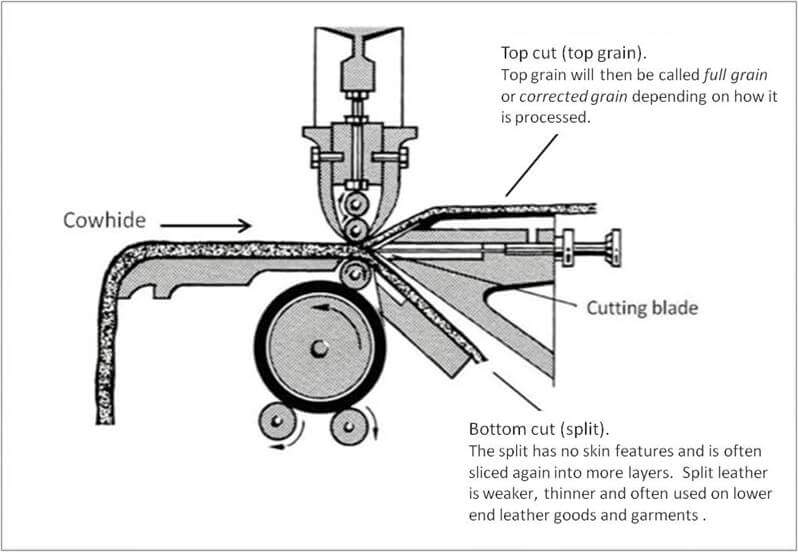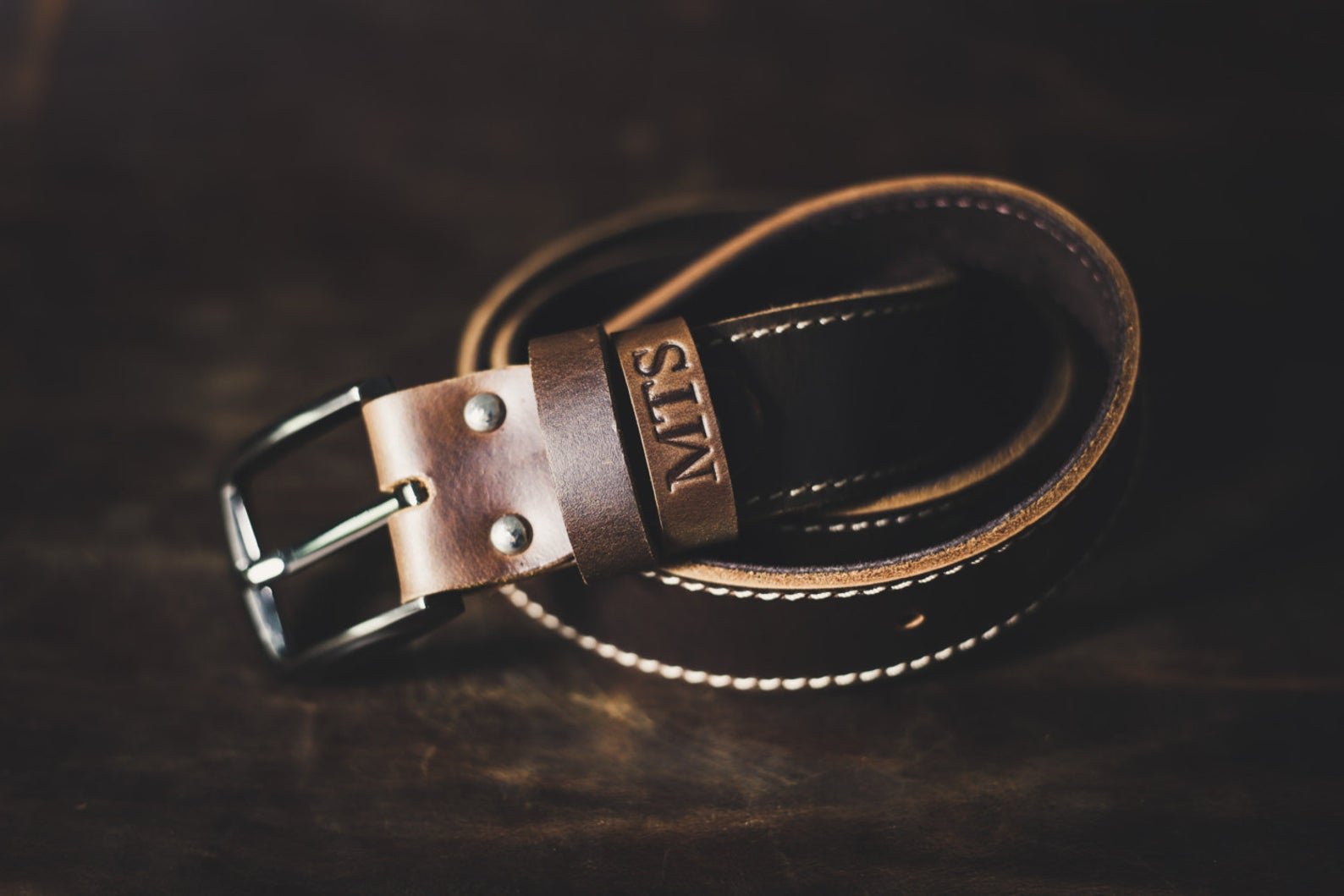Fact Check
Leather Grades: The Definitive Guide on How Leather is Graded
The five different leather grades are broad generalizations, in all reality, there are an infinite number of leather grades or at least the same number as there are tanneries in the world.
Leather Grades Explained
The five different grades of leather are as follows:
- Full-grain leather
- Top-grain leather
- Split grain leather
- Genuine leather
- Bonded leather
Genuine and bonded leather aren't technically leather grades but the terms have been popularized within the leather industry, so we'll discuss them further to explain the complete leather grade spectrum.
All grades of leather undergo some form of treatment and tanning.
Before treatment and tanning, the hide is split, and this step is crucial to understanding how the different leather grades relate to each other.
The Splitting of the Hide

The cowhide (also know as rawhide) ranges in thickness between 6 mm to 10 mm. Obviously, in the rawhide state, it not useable to make leather goods.
So the hide is split. The exact thickness of the split is determined by the customer's order and only takes the top cut into consideration.
The bottom cut has no bearing on the split.
i.e. if a customer's order was for full grain leather that was ~1.4 mm thick, the split would be greater than 1.4 mm, probably closer to 3 mm, as the top cut will be further processed and compressed to create the final end product.
The top cut is the most valuable cut and contains the full grain of the hide.
The bottom cut is the left overs and quite often is split further.
What is Full-Grain Leather
The piece of leather that has the full, complete grain of the hide intact.
All the rest of the leather grades do not have the full-grain intact.
Full-grain is the most durable and resistant to wear.
In most cases, products made from full-grain leather last a very long time and it will be the stitching that fails first.
Full-grain leather does not tear.
The two common full grain leathers are vegetable tanned leather and distressed leather.
Full-Grain Leather Samples
Top-Grain Leather
The term 'top grain' leather is widely misused.
There is a very wide range of leathers that fall under the 'top grain' umbrella.
Some top grain leathers (lower quality) are not even made from the top cut of the hide.
The best way to really understand top grain leather is to compare it to full grain leather.
Full-grain and top-grain leather are both in the top tier of leather grades made from the top cut of the hide.
They are just used to make different consumers goods.
Full-Grain Leather vs. Top-Grain Leather
Full grain leather has the complete grain intact and undergoes the least post processing at the tannery.
A typical top grain leather will have its surface buffed and sanded, both sides, then the leather surface will be further pigmented.
This processing will leave the top grain leather devoid of scarring, blemishes, etc. that you see in a full grain leather, and the surface of the top grain leather will be smooth and uniform.
Top-Grain Leather is more Water Resistance
The pigmentation process will make the top grain leather much more resistant to water and stains.
Water spilt on a top grain leather product will see the water bead on the surface and roll off.
Water on the surface of full grain leather will absorb into the leather, as full grain leather is much more porous.
The pores in top grain leather have effectively been sealed off during the pigmentation process.
Related Article: What to do When Leather Gets Wet
Full-Grain Leather Ages Better
The biggest difference between full-grain and top-grain leather might be how they age and wear over time.
A full grain leather product will form a patina.
The leather continues to look good, resisting scratches, as the leather is able to heal itself of blemishes and scratches as it absorbs oils and forms a patina.
Top grain leather is like a new car's paint job.
It looks its best on day 1, and gradually over time, as it gets nicked and scratched, the top grain leather product looks gradually worse over time.
Top grain leather products do not form patinas, nor does the leather heal itself.
Typical designer handbags are made using top grain leather.
Low-End Top Grain Leather
Remember, there are many different grades of top grain leather. Some are top notch, high grade, some are the other end of the spectrum.
Full grain leather is always the best leather available, guaranteed.
If a product is made from full grain leather, buy it!
The Bottom Cut
The three remaining leather grades are all formed using the leather from the bottom split of hide.
Split-Grain Leather
Split-grain leather doesn't contain any of the hide's grain.
Probably the most common that most people have heard of is suede.
Its used to make the soft linings of other leather products, belts, wallets, handbags, jackets, purses
Please note: The suede used to make boots (RoughOut leather) is different than the suede used for linings.
Genuine Leather
Genuine leather is a made up marketing term used to deceive the general public.
Genuine leather is the bottom of the barrel of leather grades.
Well, technically there is still bonded leather at the very bottom, but genuine leather is definitely swimming very close to the bottom.
Marketers like using the term Genuine Leather because products that usually are described as 'genuine' are regarded as valuable or of high quality.
The opposite is true in regards to Genuine Leather.
If the best description a retailer can give a product is:
"Its made from Genuine Leather", then yes its made from leather, just not the highest quality.
My rule of thumb, don’t buy genuine leather products.
Genuine Leather vs. Bonded Leather
Genuine leather is made from the bottom cut. It still technically leather, it just doesn't have any of the grain and is heavily processed.
Bonded leather is as the name implies, is leather scraps, leather dust, vinyl, glue and plastic, all bonded together.
Products made from faux leather or wax canvas, are much more resilient and of higher quality, than products made from genuine or bonded leather.
How to Tell if Leather is Real
Burn it!
You can wave a lighter against real leather and the leather won't burn. Leather is quite resistant to fire.
Obviously, don't hold it one spot for an extended period of time but if you wave it on a broad side of a wallet or a bag, it won't harm real leather. (careful, don't burn the thread)
If the leather is fake, it will burn, very quickly. It will shrivel up, just like plastic because it's made from plastic.
Sources Used to Write this Article
- Noi the Master Leathersmith from JooJoobs.com
- Awesome Article on Reddit
- LOWA Military Boots
- How to Read Bookbinding Leather
- Leather Hide Store
- Leather Buying Guide
- Understanding your Leather
- Classic Elegance
More Leather Information
If you have further leather questions, please see our Leather FAQ.


